 |
 |
 |
| |
Non-AIDS Cancer Incidence Remains the
Same Over 2004-2010 in D:A:D Study Group
|
| |
| |
The prognosis after diagnosis of NADM (non-AIDS malignancies), in particular lung cancer and disseminated cancer, is poor but has improved somewhat over time. A higher CD4 count, either at diagnosis or over follow-up, was associated with improved survival; Maintenance of a high CD4 count through use of ART is important. Smoking and IVDU were associated with poorer outcomes, as well as HCV-positivity..... look at graph below on types of cancers developing to see that liver cancer is one of the most likely cancers patients are developing
13th European AIDS Conference, October 12-15, 2011, Belgrade
Mark Mascolini
The researchers believe their findings support moves toward earlier diagnosis of HIV and non-AIDS cancers and research on better management of non-AIDS malignancies. The associations between smoking and injecting drug use and worse outcomes led the D:A:D team to propose that "focused attempts to reduce prevalence of these lifestyle factors may lead to further improvements in survival."
HIV appears to play a role in some non-AIDS-defining malignancies (NADM), which is of particular concern given the aging HIV-positive population. It is important to monitor trends in incidence rates of NADMs and survival after a diagnosis of NADM. This analysis aimed to study these issues in the D:A:D Study.
Non-AIDS cancer incidence (the new diagnosis rate) has not improved significantly from 2004 through 2009 in people with HIV, according to results of a multicohort analysis by the D:A:D Study group [1]. Incidence of lung cancer and anal cancer stayed steady, but mortality in people with non-AIDS cancer has improved slowly in recent years.
This analysis involved 8 of the 11 cohorts that make up the HIV-positive D:A:D population. Researchers validated non-AIDS cancer diagnoses made from January 1, 2004 to January 2, 2010. They calculated incidence for non-AIDS malignancies overall and individually for Hodgkin lymphoma, anal cancer, and lung cancer. Using Kaplan-Meier analysis, the D:A:D team estimated survival times from non-AIDS cancer diagnosis to death, February 1, 2010, or 6 months after the person's last clinic visit, whichever came first. This report updates D:A:D findings on non-AIDS cancer mortality published 3 years ago [2].
Through 176,776 person-years of follow-up, a new non-AIDS malignancy developed in 880 people (including 708 men), for an incidence of 4.8 per 1000 person-years (95% confidence interval [CI] 4.65 to 5.31). Forty-eight people (5.5%) had a prior non-AIDS cancer diagnosis, and 91 (10.3%) had a prior AIDS cancer. The most prevalent non-AIDS cancers were lung cancer in 140 people, Hodgkin lymphoma in 112, and anal cancer in 79. Other cancers diagnosed in 50 or more people were head and neck cancer, liver cancer, and prostate cancer.
Median age at cancer diagnosis was 50 (interquartile range [IQR] 44 to 49). Men who have sex with men accounted for 408 non-AIDS cancer diagnoses (46.4%), heterosexually infected people for 256 (29.1%), and injecting drug users (IDUs) for 153 (17.4%).
Among the 880 people diagnosed with a non-AIDS cancer, 813 (92.4%) had taken antiretrovirals. Median viral load stood at 50 copies, median CD4 count at 392 (IQR 245 to 580), and nadir CD4 count at 127 (IQR 49 to 245). One third of these people (303 patients, 34.4%) smoked, 75 (8.5%) had HCV infection, and 55 (6.3%) had HBV infection.
Incidence of all non-AIDS cancers remained stable at around 5 per 1000 person-years throughout the study period, as did incidence of lung cancer (between 0.5 and 1 per 1000 person-years) and anal cancer (around 0.5 per 1000 person-years). Hodgkin lymphoma incidence appeared to drop marginally from between 0.5 and 1 per 1000 person-years in 2004-2007 to below 0.5 in 2008-2010.
During follow-up 333 people (38% with non-AIDS cancer) died to yield an estimated overall survival of only 5.5 years. Estimated mortality stood at 28.4% 1 year after diagnosis, 42.3% 3 years after diagnosis, and 48.0% 5 years after diagnosis. One-year mortality was higher for lung cancer (57%) than for Hodgkin lymphoma (22%) or anal cancer (16%). Among the 333 people who died, 289 died of the non-AIDS malignancy.
Five factors recorded at diagnosis independently raised or lowered the risk of death, at the following adjusted relative hazards (RH) (and 95% confidence intervals):
Higher risk of death:
-- Male gender: RH 1.52 (1.10 to 2.09)
-- IDU transmission vs heterosexual: RH 1.59 (1.18 to 21.14)
-- Former smoker: RH 1.66 (1.12 to 2.46)
Lower risk of death:
-- Each later year of cancer diagnosis: RH 0.91 (0.85 to 0.98)
-- Every 50-cell higher CD4 count: RH 0.95 (0.93 to 0.98)
In addition, every 50-cell higher latest CD4 count lowered the risk of death 11% (RH 0.89, 95% CI 0.86 to 0.93).
People with lung cancer had a twice higher risk of death than people with other non-AIDS cancers (RH 2.29, 95% CI 1.76 to 2.99). In contrast, people with anal cancer had a lower risk of death than those with other non-AIDS cancers (RH 0.56, 95% CI 0.35 to 0.89), as did people with Hodgkin lymphoma (RH 0.48, 95% CI 0.32 to 0.73).
There were trends to higher death risk with older age at cancer diagnosis (RH 1.11 per 5 years, 95% CI 0.99 to 1.25), HCV-positive status at diagnosis (RH 1.28, 95% CI 0.97 to 1.90), and current smoking at cancer diagnosis (RH 1.28, 95% CI 0.87 to 1.90).
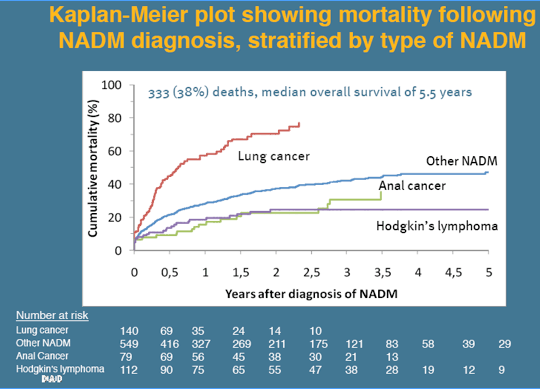
The D:A:D investigators cautioned that their analysis is limited by (1) lack of information on performance status or alcohol consumption, (2) limited data on chemotherapy, radiotherapy, and cancer dissemination or stage, and (3) no data on socioeconomic status.
The researchers believe their findings support moves toward earlier diagnosis of HIV and non-AIDS cancers and research on better management of non-AIDS malignancies. The associations between smoking and injecting drug use and worse outcomes led the D:A:D team to propose that "focused attempts to reduce prevalence of these lifestyle factors may lead to further improvements in survival."
Reference
1. Worm SW, Sabin C, Reiss P, et al. Non-AIDS defining malignancies (NADM) in the D:A:D study: time trends and predictors of survival. 13th European AIDS Conference. October 12-15, 2011. Belgrade. Abstract PS2/1.
2. Monforte A, Abrams D, Pradier C, et al. HIV-induced immunodeficiency and mortality from AIDS-defining and non-AIDS-defining malignancies. AIDS. 2008;22:2143-2153.
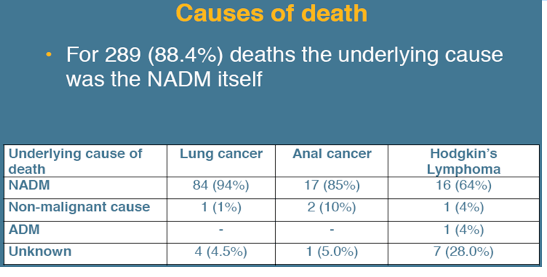
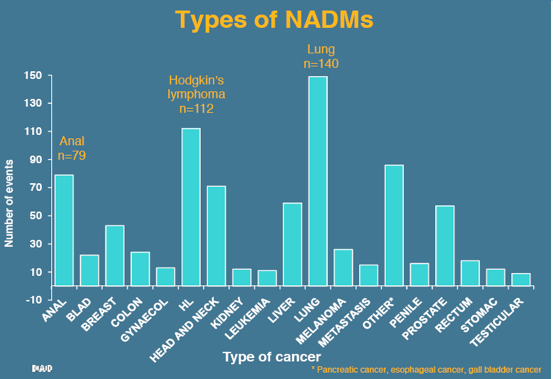
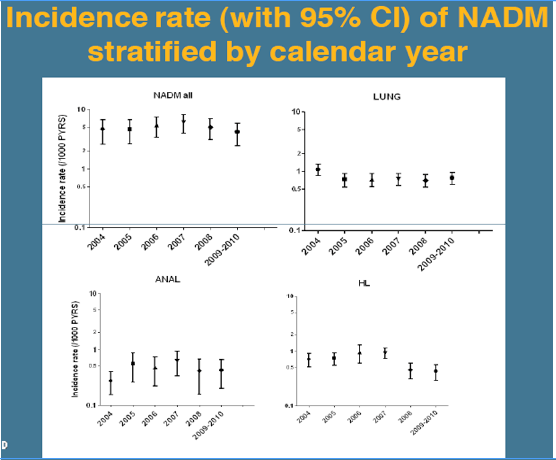
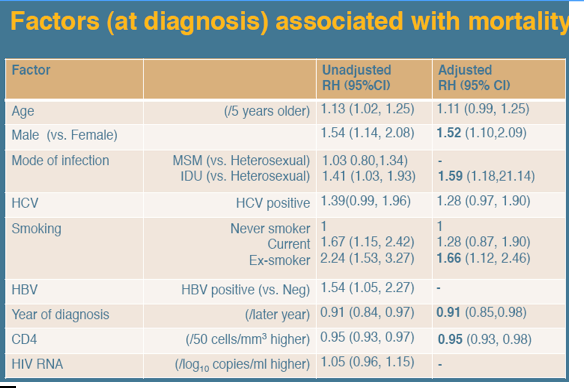
|
| |
|
 |
 |
|
|